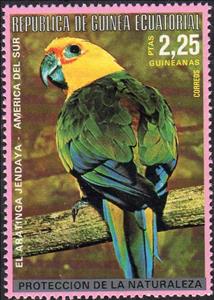Stamp: Sun Parakeet (Aratinga solstitialis) (Equatorial Guinea 1974)
Sun Parakeet (Aratinga solstitialis) (Equatorial Guinea 1974)
26 November (Equatorial Guinea ) within release Sout American and Australian birds goes into circulation Stamp Sun Parakeet (Aratinga solstitialis) face value 2.25 Equatorial Guinean peseta
| Stamp Sun Parakeet (Aratinga solstitialis) in catalogues | |
|---|---|
| Yvert et Tellier: | Yt:GQ 53E |
| Stamp Number: | Sn:GQ 74-175 |
| Michel: | Mi:GQ 487 |
Stamp is vertical format.
Also in the issue Sout American and Australian birds:
- Stamp - Black-necked Aracari (Pteroglossus aracari) face value 1.50;
- Stamp - Sun Parakeet (Aratinga solstitialis) face value 2.25;
- Stamp - Rufous-capped Motmot (Baryphthengus ruficapillus) face value 2.50;
- Stamp - Gouldian Finch (Erythrura gouldiae) face value 3;
- Stamp - Raggiana Bird-of-paradise (Paradisaea raggiana raggiana) face value 3.50;
- Stamp - Crimson-rumped Toucanet (Aulacorhynchus haematopygus) face value 20;
- Stamp - Greater Bird-of-paradise (Paradisaea apoda apoda) face value 25;
- Stamp - Dollarbird (Eurystomus orientalis) face value 30;
Stamp Sun Parakeet (Aratinga solstitialis) it reflects the thematic directions:
Birds (Aves), a subgroup of Reptiles, are the last living examples of Dinosaurs. They are a group of endothermic vertebrates, characterised by feathers, toothless beaked jaws, the laying of hard-shelled eggs, a high metabolic rate, a four-chambered heart, and a strong yet lightweight skeleton. Birds live worldwide and range in size from the 5 cm (2 in) bee hummingbird to the 2.75 m (9 ft) ostrich. They rank as the class of tetrapods with the most living species, at approximately ten thousand, with more than half of these being passerines, sometimes known as perching birds. Birds are the closest living relatives of crocodilians.
Animals are multicellular, eukaryotic organisms of the kingdom Animalia (also called Metazoa). All animals are motile, meaning they can move spontaneously and independently, at some point in their lives. Their body plan eventually becomes fixed as they develop, although some undergo a process of metamorphosis later on in their lives. All animals are heterotrophs: they must ingest other organisms or their products for sustenance.


